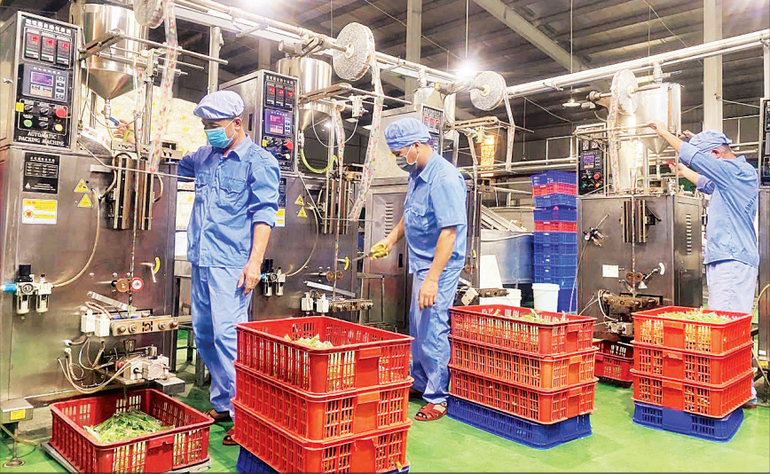Regional minimum wage increase serves as driving force for development
The decision to raise the regional minimum wage by 7.2% from 2026 aligns with growth, welfare, and wage reform goals, however it also poses challenges for businesses in improving productivity and restructuring resources.

This calls for both employees and employers to adapt flexibly, turning pressure into momentum for development.
After two meetings, on July 11, 2025, the National Wage Council agreed to propose a 7.2% increase in the regional minimum wage from January 1, 2026, equivalent to an increase of 250,000 to 350,000 VND per month depending on the region. This is the 12th adjustment since 2013, and higher than the previous two adjustments in 2022 and 2024, which both increased by 6%.
Boosting growth and social welfare
Deputy Minister of Home Affairs Nguyen Manh Khuong, Chairman of the National Wage Council, said that after analysing domestic and international socio-economic conditions, and assessing both positive and limiting factors, the Council unanimously agreed on a 7.2% increase to the minimum wage of labourers.
"The Party’s policy is to achieve high economic growth, with a target of 8% in 2025 and aiming for double digits in the following years. The wage policy must adapt to this goal and create fresh motivation for the labour force," Khuong emphasised.
Based on the Council’s consensus, the Ministry of Home Affairs will draft and submit a decree to the government to adjust the regional minimum wage from January 1, 2026, while also assessing the impact and reviewing related policy groups.
Ngo Duy Hieu, Vice President of the Viet Nam General Confederation of Labour, said the adjustment largely meets the expectations of trade s and workers. “The confederation will promote communication to encourage workers to support the decision and strive harder in their work,” Hieu stated.
Dang The Minh, a worker at Vietfoods Factory in Hapro Industrial Park (Thuan An Commune, Ha Noi), expressed joy upon hearing about the adjustment. “This is a sound policy by the State and Government in line with national development trends,” he shared. Although the additional 350,000 VND per month is not much, Minh believes it will meaningfully improve his living conditions.
For Dang Thi Tuyen, a worker at Nghi Loc Garment Factory (Nghe An), her expectations are not solely focused on the increased amount. “We have been informed about the wage hike, but in reality, our take-home pay could decrease due to higher social insurance contributions. Besides the raise, I hope there will be more tangible benefits like company trips and healthcare,” she said. What matters most to her is job stability and a steady flow of orders so that workers can raise productivity and improve their income.
These perspectives partly reflect the real-world impact of the 2026 regional minimum wage adjustment — a policy expected to motivate workers and enhance social security.
Challenges and solutions for businesses
According to Dr To Hoai Nam, Vice President of the Viet Nam Association of Small and Medium Enterprises, the 7.2% increase is relatively reasonable for ensuring social welfare and improving living standards for low-income workers.
However, in the current context, small and medium-sized enterprises (SMEs) are experiencing slow recovery, facing high input costs and weak purchasing power. The wage hike will impose significant pressure. Companies in manufacturing or labour-intensive sectors with thin profit margins may be forced to reduce staff or postpone other activities, such as investment in upgrades or innovation to offset higher labour costs.
Nam suggested considering policies to defer, reduce or suspend mandatory insurance contributions to ease the cost burden on businesses and workers. For struggling enterprises, especially exporters or those in supply chains, deferred insurance payments should be calculated.
Moreover, the Government should reinstate preferential credit programmes, interest rate support, and credit guarantees, particularly for labour-intensive SMEs. Amid rising trade risks, specialised legal and trade promotion support for this business group is also needed.

The Viet Nam Association of Small and Medium Enterprises also hopes to receive more support from Government programmes to expand assistance, help firms access market information, prepare for trade defence actions, and resolve international trade disputes.
For employers, Ha Ngoc Son, Vice Chairman of the Board of Directors of Viet Nam Food Corporation, noted: “When the minimum wage increases, labour costs, insurance, and fees all rise, leading to higher product prices. Amid economic fluctuations and intense competition, especially from cheap and high-quality imports from the US, domestic manufacturers must restructure quickly, boost productivity, or risk losing market share.”
However, Son added that by taking advantage of falling machinery import prices, businesses could invest in technology to adapt and turn pressure into opportunity.
A representative from Ha Noi Textile and Garment Joint Stock Corporation (Hanosimex) shared that the ongoing regional minimum wage hikes place a heavy financial burden, particularly on labour-intensive garment companies. This affects future workforce planning as firms must align their production and business strategies with cost-effectiveness.
Nonetheless, the wage increase indirectly prompts restructuring and productivity gains. Hanosimex hopes the State will ensure a fair competitive environment and offer more preferential policies to enterprises employing large workforces, especially older workers.
The 2026 regional minimum wage adjustment is a key step in wage reform, contributing to income improvement, labour market stability, and socio-economic development.
For the policy to be effective, both workers and businesses must adapt flexibly. Workers need to improve their skills and productivity, while businesses must restructure, adopt technology, and enhance management to optimise costs and strengthen competitiveness. When both sides share the burden and move forward together, the minimum wage increase can become a common driving force for sustainable development.








